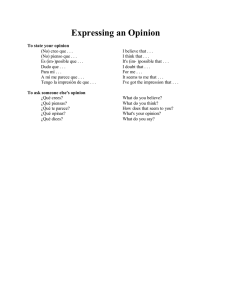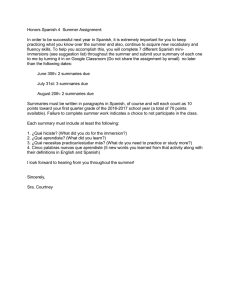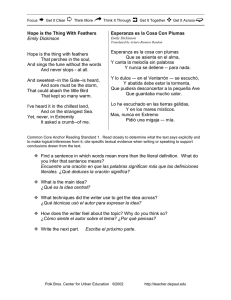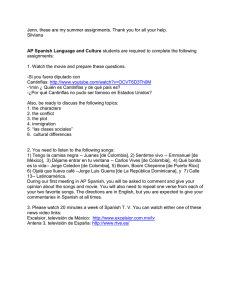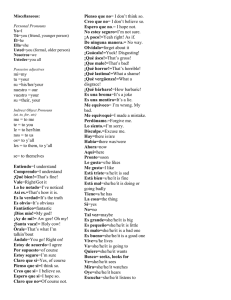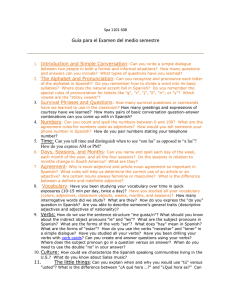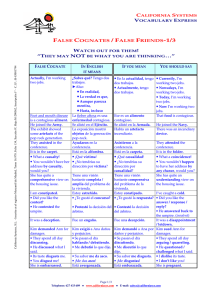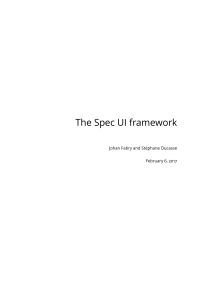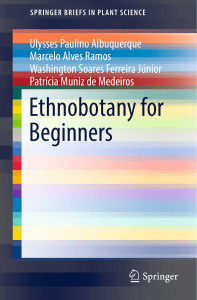SPEC OF IP AND SPEC OF CP IN SPANISH WH
Anuncio
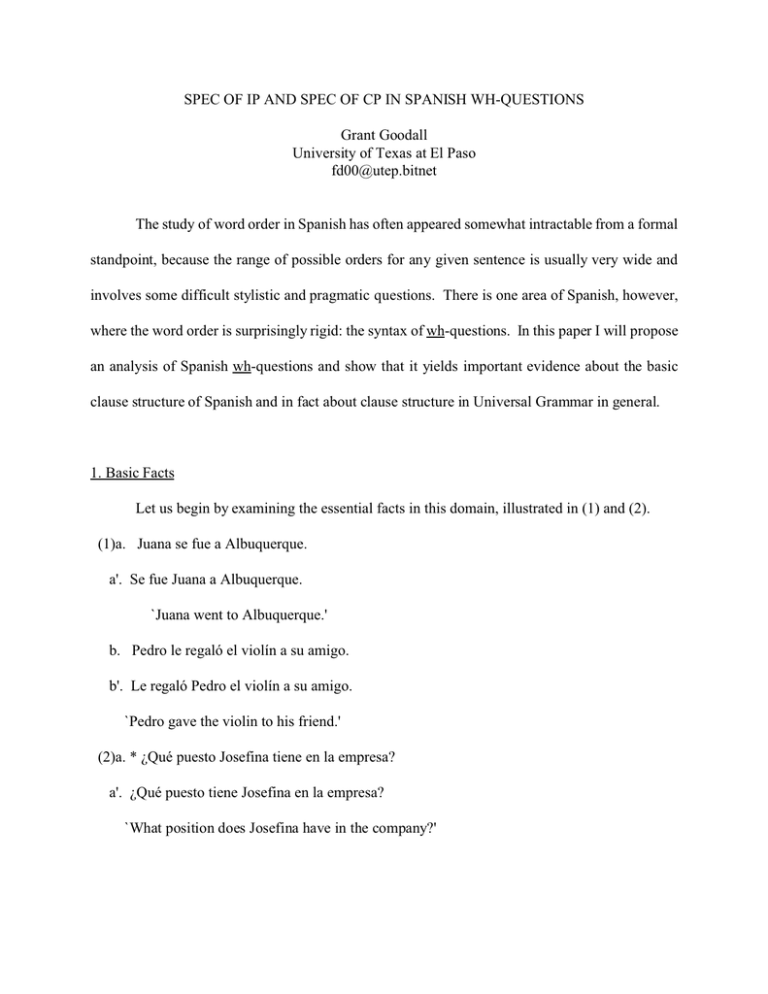
SPEC OF IP AND SPEC OF CP IN SPANISH WH-QUESTIONS Grant Goodall University of Texas at El Paso [email protected] The study of word order in Spanish has often appeared somewhat intractable from a formal standpoint, because the range of possible orders for any given sentence is usually very wide and involves some difficult stylistic and pragmatic questions. There is one area of Spanish, however, where the word order is surprisingly rigid: the syntax of wh-questions. In this paper I will propose an analysis of Spanish wh-questions and show that it yields important evidence about the basic clause structure of Spanish and in fact about clause structure in Universal Grammar in general. 1. Basic Facts Let us begin by examining the essential facts in this domain, illustrated in (1) and (2). (1)a. Juana se fue a Albuquerque. a'. Se fue Juana a Albuquerque. `Juana went to Albuquerque.' b. Pedro le regaló el violín a su amigo. b'. Le regaló Pedro el violín a su amigo. `Pedro gave the violin to his friend.' (2)a. * ¿Qué puesto Josefina tiene en la empresa? a'. ¿Qué puesto tiene Josefina en la empresa? `What position does Josefina have in the company?' b. * ¿A quién Pedro le regaló el violín? b.' ¿A quién le regaló Pedro el violín? `Who did Pedro give his violin to?' c. * ¿Cómo Juana se fue a Albuquerque? c.' ¿Cómo se fue Juana a Albuquerque? `How did Juana go to Albuquerque?' d. * ¿Dónde Bertha compra el periódico? d.' ¿Dónde compra Bertha el periódico? `Where does Bertha buy the newspaper?' e. * ¿Cuándo Juana se fue a Albuquerque? e'. ¿Cuándo se fue Juana a Albuquerque? `When did Juana go to Albuquerque?' In (1) we see some examples of the variability in word order that is typical of Spanish. In (2) we see that following a fronted wh-word, only the verb-initial order is possible. This general type of data is not at all peculiar to Spanish. In English and in several other Germanic languages (and in languages of other families too), a verbal element must follow immediately after a fronted wh-phrase, as seen in (3). (3)a. *Where you can ride your bike? b. Where can you ride your bike? This is an instantiation of the phenomenon known as V2. Within the Barriers framework of Chomsky (1986), this phenomenon is commonly accounted for by saying that V-I is required to move into C when SPEC of CP is filled. Could this be what is happening with Spanish cases such as (2)? I will argue here that the answer is no. Consider first the fact that the word order restriction that we see in (2) also occurs in embedded questions, as shown in (4). (4)a. * No me acuerdo qué puesto Josefina tiene. b. No me acuerdo qué puesto tiene Josefina. `I don't remember what position Josefina has.' This is not ruled out in an analysis involving movement into C, but it does seem to be discouraged for some reason. Witness embedded questions in Standard English, for instance, where movement into C is disallowed: (5) * I don't remember where can you ride your bike. What is clearly ruled out is movement into C in the presence of a complementizer (i.e. when C is filled). The fact that Spanish allows the complementizer to be directly followed by the verb, as in (6), thus argues that the verb-initial order we have been observing is not the result of moving V into C. (6)a. Creo que se fue Juana a Albuquerque. `I think that Juana went to Albuquerque.' b. No sé si se fue Juana a Albuquerque. `I don't know whether Juana went to Albuquerque.' Another argument against movement of V-I into C comes from the fact that the contrast seen in (2) does not obtain with wh-phrases of the por qué `why' class. As shown in (7), either order is possible with por qué. (7)a. ¿Por qué Luis Miguel trabaja tanto? b. ¿Por qué trabaja tanto Luis Miguel? `Why does Luis Miguel work so much? In a V2 model, it is difficult to see why some wh-words would triger movement of V-I into C while others would not. A final argument against Germanic-style V2 for Spanish has to do with the behavior of adverbs such as apenas `barely', which strongly prefer to be positioned to the immediate left of V-I, as in (8). (8)a. José Luis apenas veía la pantalla desde ese asiento. `José Luis could barely see the screen from that seat.' b. Uds. sólo pueden comer arroz cuando están en Japón. `You can only eat rice when you are in Japan.' c. Yo sencillamente no aguanto a ese mocoso. `I simply can't stand that brat.' d. Las mujeres regularmente sonríen más que los hombres. `Women usually smile more than men.' If V-I really moves into C, then in wh-questions we should find V-I to the left of the adverb, which would remain in its base position. This is not what happens, however, as may be seen in (9). (9)a. ¿Desde cuál asiento apenas veías la pantalla? `From which seat could you barely see the screen?' b. ¿En cuál país sólo pueden comer arroz? `In which country can you only eat rice? c. ¿A cuál de esos mocosos sencillamente no aguantas? `Which of those brats can you simply not stand?' d. ¿Por qué regularmente sonríen más las mujeres? `Why do women usually smile more?' These facts in (9) may be profitably compared with the corresponding ones from English in (10), where it appears that I does move into C, to the left of the adverb. (10)a. John barely could see the screen from that seat. b. *From which seat barely could John see the screen? c. From which seat could John barely see the screen? (11)a. They only will eat rice. b. *In what country only will they eat rice? c. In what country will they only eat rice? (12)a. I simply can not stand that brat. b. *Which brat simply can you not stand? c. Which brat can you simply not stand? (13)a. Women usually are smiling. b. *Why usually are women smiling? c. Why are women usually smiling? 2. Movement into SPEC of IP We can now reasonably conclude that V does not move into C in Spanish wh-questions. What then accounts for the word order facts we saw in (2)? There are two possibilities: either the subject NP obligatorily moves rightward in wh-questions, or V is base-generated in initial position within the clause, and it is only in non-wh-sentences that the subject NP moves leftward. The first possibility would seem to have nothing to recommend it, since there is no reason why the subject NP should move to the right when the wh-phrase moves into SPEC of CP. I shall thus adopt the second possibility, that V is base-generated in clause-initial position, as has been independently proposed by Contreras (1987). Groos and Bok-Bennema (1986) make the important observation that by adopting this proposal of Contreras', we can then very elegantly account for the facts in (2). All we need to say is that there is a single XP position to the left of V into which either a wh-phrase or the subject (but of course not both) may move. (1) and (2) then follow directly. What is this XP position? Within the Barriers framework the most obvious choice would be SPEC of CP, but the fact that preverbal subjects appear to the right of C, as in (14), would seem to rule this possibility out. (14) Creo que Juana se fue a Albuquerque. `I believe that Juana went to Albuquerque.' A more satisfactory alternative is to adopt the VP-internal subject hypothesis of Kuroda (1988), Koopman and Sportiche (1988), and others, and say that the subject originates in a post-verbal position inside VP (for the sake of concreteness, let us say in the SPEC of VP position), and that it is SPEC of IP which both the subject and the wh-phrase compete for. SPEC of IP thus becomes an A'-position in Spanish, since it is never assigned a 1-role. Diesing (1990) reaches the same conclusion in her analysis of Yiddish. We have now seen, then, that there is good evidence that V remains in situ in Spanish whquestions, which thus supports an analysis along the lines of Groos and Bok-Bennema in which there is a single preverbal position (probably SPEC of IP) into which either a wh-phrase or the subject may move. This analysis yields a principled account of the contrast between (1) and (2). 3. Movement into SPEC of CP Despite the considerable attractiveness of the above analysis, however, there is strong evidence that in and of itself it cannot be right. Specifically, I will show here that preposed whphrases and preposed subjects do not occupy the same position: wh-phrases are in SPEC of CP and preverbal subjects are in SPEC of IP, just as the more traditional account would suggest. Consider first the contrast between overt subjects of embedded infinitival clauses and whphrases which have been extracted out of such positions, as seen in (15) and (16). (15)a. ?* Yo considero esta novela de Borges ser la más interesante. `I consider this novel by Borges to be the most interesting.' b. * Yo creo esta película ser la mejor. `I believe this movie to be the best.' c. * Yo decía esta casa ser muy bonita. `I said this house to be very pretty.' (16)a. ? ¿Cuál novela consideras ser la más interesante? `Which novel do you consider to be the most interesting?' b. ?? La película que yo creo ser la mejor es "El Ultimo Emperador." `The movie which I believe to be the best is "The Last Emperor."' c. ? Cuál casa decían ser muy bonita? `Which house did they say to be very pretty?' The ungrammaticality of the sentences in (15) is not at all surprising, since the embedded subjects appear to have no way to get Case. The relative grammaticality of the sentences in (16) must then be due to the wh-phrase's ability to pick up Case from some other position. Following the analysis of Rizzi (1981) and Kayne (1984) for Italian and French, respectively, this is because the wh-phrase has a trace in COMP (i.e. SPEC of CP) and the matrix verb may assign Case to this position. The subject, in contrast, is in SPEC of IP. A second argument in favor of distinct positions for wh-phrases and subjects comes from the fact that in some dialects a PP may be wh-extracted out of a fronted wh-phrase but not out of a preverbal subject (Torrego (1985), Chomsky (1986)): (17)a. *Esta es la autora de la que [varias traducciones t] han ganado premios internacionales. `This is the author by whom several translations have won international award.' b. ¿De qué autora no sabes [qué traducciones t] han ganado premios internacionales? `By what author don't you know what translations have won international awards?' This is presumably because the PP-trace is antecedent-governed in (b) but not in (a), thus suggesting that the subject [varias traducciones t] is in SPEC of IP and the wh-phrase [qué traducciones t] is in SPEC of CP. For a third piece of evidence, let us turn to wh-movement out of multiply embedded clauses, as in (18). (18) ¿Qué puesto dijo Manolo que Iris cree que Josefina ocupa en la empresa? `Which position did Manolo say that Iris believes that Josefina has in the company?' In this example, Subjacency should force the wh-phrase to stop off in at least one of the embedded clauses before moving into the matrix clause. If the landing site is SPEC of IP, then at least one of the embedded subjects should be obligatorily post-verbal. Such is not the case, however, as (18) shows (for most dialects, at least), thus again suggesting that wh-phrases move into SPEC of CP. 4. Movement into SPEC of IP and SPEC of CP At this point, then, we have seen evidence from sections 1 and 2 that V-I stays in situ in whquestions and that the wh-phrase and the subject compete for the same preverbal position (SPEC of IP), while section 3 shows that wh-phrases and preverbal subjects occupy different positions. This would appear to be a contradiction, but in fact it is not. The way out of this dilemna is to say that in [+wh] clauses (such as the matrix clause in (18)), the wh-phrase must move into SPEC of IP before moving into SPEC of CP. This accounts for why preverbal subjects are disallowed in [+wh] clauses, be they matrix (as in (2)) or embedded (as in (4)), and for why fronted wh-phrases and preverbal subjects occupy different positions (as we saw in (15)-(18)). In addition, this account makes some very interesting predictions. First, we expect that in clauses which are [-wh] but in which there is movement, the wh-phrase will be able to move directly into SPEC of CP, without stopping in SPEC of IP. This is what happens in the embedded clauses in (18), but it should also occur in relative clauses, which are standardly assumed to be [-wh]. That this is true is shown by the lack of contrast between (19)(a) and (b). (19)a. Esta es la muchacha que todos conocemos. b. Esta es la muchacha que conocemos todos. `This is the girl that we all know.' Since the wh-phrase does not need to pass through SPEC of IP, the subject is free to move there, as in (19a). The second prediction made by this analysis is that if the clause is [+wh] but there is no whmovement, then the subject shall again be free to move into the preverbal SPEC of IP position. There are two cases where this prediction can be tested. The first is with complementizers of the whether class (si in Spanish), which appear to be [+wh], as shown in (20). (20)a. No sé si Juana se fue a Albuquerque. b. No sé si se fue Juana a Albuquerque. `I don't know whether Juana went to Albuquerque.' The prediction is correct, in that the subject has moved into SPEC of IP in (20a). The second case is the most striking. It has been argued that wh-words such as why are base-generated in SPEC of CP. Rizzi (1990), for example, shows that French in situ wh-questions are allowed with all whwords except pourquoi `why', as seen in (21). (21)a. Il a parlé de quoi? `He spoke about what?' b. Il a parlé comment? `He spoke how?' c. *? Il a parlé pourquoi? `He spoke why?' This otherwise bizarre fact is easily explained if only pourquoi starts out in SPEC of CP position (simplifying Rizzi's account somewhat). If we assume that por qué in Spanish works in the same way, then we clearly predict that the subject will be able to move into SPEC of IP in a [+wh] clause headed by por qué, since no wh-phrase will pass through that position. This prediction is confirmed by the data shown earlier in (7), repeated here as (22). (22)a. ¿Por qué Luis Miguel trabaja tanto? b. ¿Por que trabaja tanto Luis Miguel? `Why does Luis Miguel work so much?' Here the subject may freely appear in the preverbal position. Similar facts obtain with the wh-expression cómo que `how can it be that.' The presence of the overt complementizer que hints that no movement into SPEC of CP has occured, and the behavior of the subject confirms this, as seen in (23). (23)a. ¿Cómo que Juana se fue a Albuquerque? b. ¿Cómo que se fue Juana a Albuquerque? `How can it be that Juana went to Albuequerque?' Here again, the subject is free to move into SPEC of IP, since there is no wh-movement. These facts in (19)-(20) and (22)-(23) thus provide further support (in addition to the data seen in sections 1-3) for the hypothesis that wh-phrases land in both SPEC of IP and SPEC of CP when they move into [+wh] clauses. 5. Dialectal Variation The data presented in this article so far are based on informant work with several dozen native speakers from a number of countries and appear to be representative of most, if not all, of mainland Latin American Spanish. There are at least two other dialects of Spanish, however, whose word-order properties in wh-questions differ significantly from those of the dialect considered above. The first of these is the Peninsular Spanish dialect of Torrego (1984). In this variety, sentences like (18) (repeated here as (24)) are ungrammatical, since at least one of the embedded subjects must appear in a post-verbal position. (24) ¿Qué puesto dijo Manolo que Iris cree que Josefina ocupa en la empresa? `Which position did Manolo say that Iris believes that Josefina has in the company?' Thus unlike Latin American Spanish, in which the wh-phrase needs to land in SPEC of IP only in [+wh] clauses, this dialect apparently requires the wh-phrase to move into both SPEC of IP and SPEC of CP in any clause embedded under a [+wh] clause (apart from those clauses into which Subjacency does not require movement). Similar facts are reported in Finer (1991) for Selayarese. [-wh] clauses which are not embedded under [+wh] clauses, such as relative clauses, do not require movement into SPEC of IP. Thus in both Torrego's and the Latin American dialects the subject may appear in pre-verbal position in relative clauses, as seen in (19) (repeated here as (25)). (25)a. Esta es la muchacha que todos conocemos. b. Esta es la muchacha que conocemos todos. `This is the girl that we all know.' The other well-known dialect which presents substantial differences in the form of whquestions is Caribbean Spanish. In this dialect, the basic contrasts which we saw earlier in (2) apparently do not obtain. That is, the subject may appear in pre-verbal position regardless of the movement of a wh-phrase. This seems to indicate that wh-movement in this dialect is as in English and many other languages where the wh-phrase moves directly into SPEC of CP. SPEC of IP is thus always available for the subject. For a discussion of what determines whether a wh-phrase will need to land in SPEC of IP in a given language, see Goodall (1991). 5. Conclusion I have been implicitly assuming in the presentation of this analysis that Spanish is underlyingly a VOS language. The subject originates in SPEC of VP at the right periphery of VP and may either remain there or move into SPEC of IP if that position is available. In fact, an underlying SVO order, in which the SPEC of VP is at the left periphery of VP would also be consistent with the analysis presented here, if we assume that V obligatorily moves to I. Under either scenario, SPEC of VP will need to be able to receive Case. I will assume here that I governs the SPEC of its complement, thus allowing SPEC of VP to receive nominative Case (see also den Besten (1981) and Roberts (1987) for discussion of Case-marking into VP by I). Either scenario will also have to account for the position of the subject in examples like (2b'). This surface VSO order might be the result of the sort of mechanism described in Chung (1991), but I will not pursue this question here. These and other interesting issues aside, there are two main contributions that I hope to have been able to make here. On the descriptive side, I have attempted to provide a plausible and principled explanation for the basic contrast seen in (2), in both matrix and embedded clauses, and for why this contrast does not obtain in certain cases. On the theoretical side, I have provided new types of evidence that SPEC of IP is not only a 1-bar position, but also a potential A-bar position. Acknowledgements This research was supported in part by National Science Foundation grant #BNS-8909935 to the University of Texas at El Paso and by a Faculty Development grant from the College of Liberal Arts, University of Texas at El Paso. Gloria González Gómez worked as a research assistant on this project and I am greatly indebted to her for her invaluable help. My thanks go also to the participants of LSRL XXI for their many useful comments and suggestions. References Besten, Hans den. 1981. "Government, Syntaktische Struktur und Kasus". Sprache, Formen, und Strukturen ed. by M. Kohrt and J. Lenerz. Tübingen: Max Niemeyer Verlag. Chomsky, Noam. 1986. Barriers. Cambridge: MIT Press. Chung, Sandra. 1991. "VP's and Verb Movement in Chamorro". Natural Language and Linguistic Theory 8.559-619. Contreras, Heles. 1987. "Small Clauses in Spanish and English". Natural Language and Linguistic Theory 5.225-243. Diesing, Molly. 1990. "Verb Movement and the Subject Position in Yiddish". Natural Language and Linguistic Theory 8.41-79. Finer, Daniel. 1991. "C-Agreement, SPEC of IP, and Binding Domains in Selayarese". Unpublished manuscript, SUNY Stony Brook. Goodall, Grant. 1991. "On the Status of SPEC of IP". Paper presented at West Coast Conference on Formal Linguistics X, Arizona State University. Groos, Anneke and Reineke Bok-Bennema. 1986. "The Structure of the Sentence in Spanish". Generative Studies in Spanish Syntax ed. by Ivonne Bordelois, Heles Contreras, and Karen Zagona, 67-80, Dordrecht: Foris. Kayne, Richard. 1984. Connectedness and Binary Branching. Dordrecht: Foris. Koopman, Hilda and Dominique Sportiche. 1988. "Subjects". Unpublished manuscript. UCLA. Kuroda, S.-Y. 1988. "Whether We Agree or Not: A Comparative Study of English and Japanese". Linguisticae Investigationes 12.1-47. Rizzi, Luigi. 1981. "Nominative Marking in Italian Infinitives and the Nominative Island Constraint". Binding and Filtering ed. by Frank Heny, 129-157. Cambridge: MIT Press. Rizzi, Luigi. 1990. Relativized Minimality. Cambridge: MIT Press. Roberts, Ian. 1987. The Representation of Implicit and Dethematized Subjects. Dordrecht: Foris. Torrego, Esther. 1984. "On Inversion in Spanish and Some of its Effects". Linguistic Inquiry 15.103130. Torrego, Esther. 1985. "On Empty Categories in Nominals". Unpublished manuscript. University of Massachusetts, Boston.
